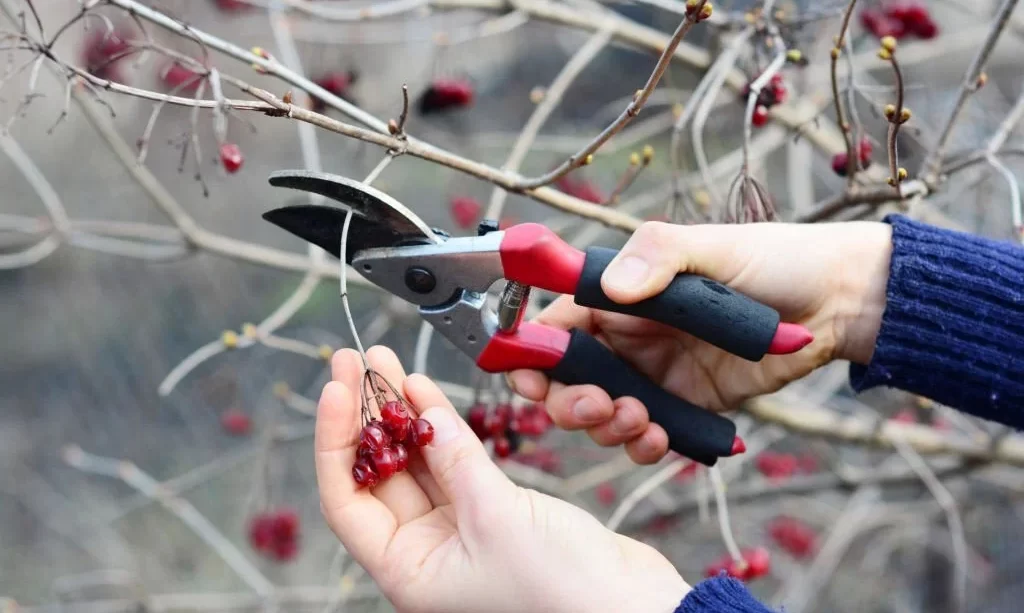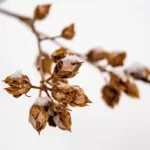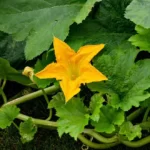Viburnum shrubs, with their lush foliage, fragrant blossoms, and diverse species, are cherished additions to gardens and landscapes. These versatile plants not only provide visual appeal but also attract pollinators and birds, making them a favorite among garden enthusiasts. However, to ensure the health and beauty of your viburnum shrubs, it’s essential to know when and how to prune them. In this exploration, we delve into the art and science of viburnum pruning, beginning with a fundamental understanding of the process.
- MAKE PRUNING WORK EASIER: Rust-resistant stainless steel blade are sharp and durable for easy and smooth cut.Anti-slip and ergonomic handle make the gardener clippers more comfortable in your hand.Easy-open spring action reduces hand fatigue while cutting. you can easily to cut without damaging the vital stems and branches of your plants.
- User-FRIENDLY SAFETY LOCK:These garden shears have locking mechanisms to keep the sharp blades securely closed when not in use.It is easy to maneuver and can effectively reduce accidental injuries.
- GARDEN GLOVES: This Gardening gloves,made of soft & comfortable cotton fabric,can protect yourself from dirt, skin wounds and nasty splinters when doing yard chores. The grip latex coating provides anti-slip or sure control when grabbing garden & yard tools.
- COMFORTABLE HANDLE: The handle part of the pruning shears made by high-purity PP+TPR plastic, especially the hand grip is very comfortable, but also has strong toughness and strength.
- PACKING LISTING: The packing include pruning shear, fruits shear, flower cutter, leaves trimmer, one pair glove, one organizer bag.Those pruning shears could satisfy need of planting, harvesting, floral, indoor and outdoor planting, greenhouse pruning.
Viburnum Pruning
Pruning is a horticultural practice that involves selectively trimming branches and foliage from plants. When it comes to viburnum shrubs, this careful maintenance technique serves several crucial purposes:
- Promoting Healthy Growth: Pruning helps remove dead, diseased, or damaged branches, allowing the plant to direct its energy towards healthy growth. It also improves air circulation, reducing the risk of fungal diseases.
- Shaping and Aesthetics: Viburnums can be shaped to suit your garden’s aesthetic. Pruning allows you to create desired forms, from naturalistic shapes to formal hedges.
- Enhancing Flowering: Properly timed pruning can stimulate the development of more flowers and fruit, leading to a more vibrant and fruitful shrub.
- Size Control: Viburnum shrubs vary in size, and pruning can be used to maintain the plant’s dimensions and prevent it from overgrowing its space.
Understanding the principles of viburnum pruning, including when to prune and the specific goals you want to achieve, lays the foundation for nurturing healthy, beautiful shrubs that contribute to the charm of your garden. In the following sections, we’ll delve into the intricacies of when and how to prune these remarkable plants, ensuring they thrive and grace your landscape with their splendor.
Best Time to Prune Viburnum
Determining the ideal time for pruning viburnum shrubs is crucial for achieving your desired results. The timing largely depends on the specific species of viburnum and your pruning goals. Here are the two primary pruning periods:
- Winter/Spring Pruning: Many viburnum species benefit from pruning during late winter or early spring before new growth begins. This timing is ideal for rejuvenation pruning and the removal of dead, damaged, or crowded branches. It’s a way to invigorate the shrub and prepare it for the upcoming growing season.
- Pruning After Flowering: Some viburnum varieties are best pruned after they’ve finished flowering, typically in late spring or early summer. This timing allows you to shape the shrub and maintain its desired size without sacrificing the current year’s blooms. Pruning after flowering is particularly relevant for viburnums that bloom on old wood.
Winter/Spring Pruning
Pruning viburnum shrubs during late winter or early spring offers several advantages:
- Rejuvenation: This timing allows for rejuvenation pruning, which involves the removal of older, less productive branches, encouraging the growth of new, healthy shoots.
- Enhanced Blooms: For some viburnum species, pruning during this period can stimulate the development of more flowers, resulting in a more vibrant and prolific blooming season.
- Reducing Disease Risk: Removing dead or diseased branches before the growing season can minimize the risk of fungal diseases and improve overall plant health.
When undertaking winter/spring pruning, use sharp, clean pruning shears or loppers to make precise cuts. Ensure that you remove no more than one-third of the total shrub’s growth to avoid stressing the plant excessively.
Pruning After Flowering
Pruning viburnum shrubs after they’ve completed their flowering cycle, typically in late spring or early summer, is advantageous for several reasons:
- Preserving Blooms: Pruning after flowering allows you to shape the shrub without sacrificing the current year’s blooms. This timing is crucial for viburnum varieties that bloom on old wood, where flower buds form on the previous year’s growth.
- Shaping and Maintenance: You can maintain the desired size and shape of the shrub without interfering with the floral display.
- Reducing Stress: Pruning during this period minimizes the risk of stressing the plant, as it has completed its primary growth phase for the season.
When conducting post-flowering pruning, be mindful of the shrub’s natural shape and your desired aesthetic. Use sharp, clean pruning tools to make precise cuts, removing any dead or overgrown branches to maintain the plant’s health and appearance.
Understanding the right time to prune your viburnum shrubs and selecting the appropriate timing based on their species and growth patterns ensures that your pruning efforts yield the best results, enhancing the beauty and vitality of these remarkable plants in your garden.
Pruning Specific Viburnum Varieties
Different viburnum species may have unique pruning requirements. Here, we address some common viburnum varieties and provide guidance on how to prune them effectively:
- Viburnum opulus (European Cranberry Bush): This deciduous shrub benefits from rejuvenation pruning in late winter or early spring to encourage vigorous new growth. Remove a portion of the older wood to promote a healthier, more productive shrub.
- Viburnum tinus (Laurustinus): Pruning after flowering can help shape and maintain the size of this evergreen shrub. Trim back leggy growth and remove dead or crowded branches to keep it looking tidy.
- Viburnum plicatum (Japanese Snowball Bush): These shrubs are best pruned immediately after flowering to preserve their ornamental globe-shaped clusters of white flowers. Lightly trim back branches to maintain their natural form.
- Viburnum dentatum (Arrowwood Viburnum): This deciduous viburnum is often pruned in late winter or early spring for rejuvenation. Remove up to one-third of the older wood to encourage new shoots.
Special Cases and Maintenance Pruning
In some cases, you may encounter special scenarios or ongoing maintenance needs for your viburnum shrubs:
- Pruning Young Viburnums: Young viburnum shrubs benefit from light pruning to shape their growth and encourage branching. Focus on removing any crossing or competing branches to create a strong, well-structured plant.
- Maintenance Pruning: Regular maintenance pruning, regardless of the species, involves removing dead or diseased branches, as well as occasional light shaping to keep the shrub looking its best. This can be done as needed throughout the year.
- Avoiding Severe Pruning: While viburnum shrubs can tolerate pruning well, it’s essential to avoid severe or excessive pruning, as this can stress the plant and affect its overall health. Aim to maintain the natural shape and structure of the shrub.
Conclusion
Pruning viburnum shrubs is a vital aspect of their care, ensuring they remain healthy, shapely, and vibrant. Understanding the specific timing and requirements for your particular viburnum species allows you to make informed decisions about when and how to prune.
Whether you’re rejuvenating older shrubs, shaping younger ones, or maintaining the beauty of well-established viburnum specimens, pruning plays a pivotal role in their overall health and appearance. By following the guidelines for your specific viburnum variety and adhering to proper pruning techniques, you can enjoy these remarkable plants at their best, contributing to the allure and charm of your garden or landscape.




